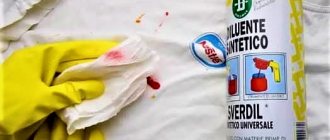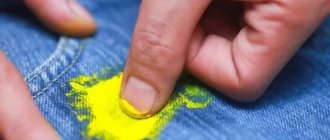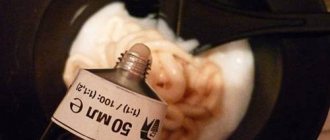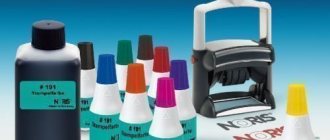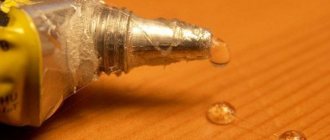It is difficult to get rid of oil paint, but if you use the advice of professionals, then the stain on your clothes will not even remain a memory.
Household chemicals and improvised means come to the rescue. Therefore, you should not throw away an item that has been exposed to persistent dye.
You need to start processing it immediately, before the composition dries. We'll tell you in this article how to remove oil paint from clothes at home.
How to remove paint from fabric
First of all, you need to determine the type of contamination. All dyes are conventionally divided into groups:
- water-soluble (watercolor, water-based solutions, gouache, tempera);
- other dyes that dissolve in various substances (oil, acrylic, latex, enamel).
Fresh watercolor stains on children's clothes can be washed off with cold water. It is recommended to pre-soak old traces of dyes for 15-30 minutes. Gouache contains an adhesive and oil base, so it takes longer to wash off than watercolor. How to remove paint from clothes made of thick fabric? This is not difficult, and the means at hand can be found in every home. For example:
- you can prepare a solution of oxalic acid and ammonia;
- no less effective is a mixture of glycerin, industrial alcohol and ammonia.
Tempera in composition refers to intermediate compositions between water and oil dyes. In this regard, removal should be carried out in the same way as getting rid of grease stains. Water-based mortars can be easily removed from work pants with soapy water. How to remove paint from clothes made of delicate fabric: it is better to use special stain removers, such as Bos or Vanish.
Acrylic or latex dyes are water-soluble, but over time the stain will be impossible to remove after one wash. Fresh dirt should be carefully blotted with absorbent material to prevent the composition from being absorbed into the fabric. How to remove acrylic paint from clothes? It is recommended to rub the old stain under running water and load the item into the machine. Wash at a temperature no higher than 30 degrees.
Oil and enamel dyes are the most difficult stains for fabric. Before deciding how to remove paint from clothes, you need to make sure that the material will not be damaged. Serious solvents can damage fabric, so test before use. How to remove oil paint from clothes? Use solvents (eg 646 or 647). If the case is very complex and advanced, try acetone. To reduce gasoline pollution, get the formula from the hardware store, not the one you use to fill your car.
Several ways to remove paint from clothes:
- Dishwashing detergents will help you if you've just stained your clothes. The stain just needs to be rubbed with a sponge and washed off with water.
- Cleaning powder with butter also helps solve problems with such stains. Mix the substances in a 1/1 ratio, rub the stain for some time, rinse with water. After this, wash the item.
- Vegetable oil is suitable for cleaning items made of synthetics, cashmere or leather. Apply it to a cotton pad and rub the stained area until the paint disappears. When the procedure is finished, you will need to remove the oil stain (to do this, pour salt on it and rinse it).
- White spirit is suitable for combating different types of stains, but it is better to choose it for removing enamel. You need to wet the tampon with this substance and rub the fabric.
- Gasoline is used in extreme cases. They are filled with pollution for a while. The disadvantage of this method is that traces of gasoline may remain on the fabric.
Oily
Produced on the basis of drying oil. Any type of fat base solvent will do. It takes a long time to dry, so you have time to buy one of these products.
Petrol
- Place a clean towel under the product.
- Wet a piece of clean cloth with purified gasoline and wipe the stain with it.
- When the fabric gets dirty, replace it with a new one.
- Then wash the product in the usual way.
White Spirit
This is a gasoline solvent, a type of kerosene. It is a colorless transparent liquid. Can be purchased at a hardware store. Wipe the stain with a cotton pad soaked in white spirit until it completely disappears.
If the oil paint has already dried, do the same as with acrylic paint - wet a cotton pad with solvent and apply it to the stain for 20 minutes, and then rub it with detergent and a brush.
Turpentine
This is a mixture of essential oils obtained from different parts of pine trees. It perfectly removes both fat and particles of coloring pigment.
- Apply it to the stain and leave until completely dry.
- Then rinse and wash the item.
Useful
To prevent streaks from remaining on the fabric, you can wipe this area with ammonia.
Glycerin for delicate fabrics
Read about: how to remove mold from clothes.
Using glycerin (sold in pharmacies) you can process natural silk and other fabrics that require careful care. Suitable for removing fresh stains.
- You need to heat it up and apply it to the contaminated area of the product.
- Leave for a quarter of an hour, rinse and rub the fabric with laundry soap.
- Then wash in warm water with liquid detergent.
Do not delay washing and do not wait for the paint to dry. But even if this happens, do not despair. By using one of the methods described, you can save your favorite item. Be careful when working with flammable liquids and follow safety precautions.
© 2022 textiletrend.ru
How to remove paint from clothes with solvents
If you get dirty, don’t rush to throw away your clothes. Try to remove the dirt. Acetone, which is part of many solvents, does an excellent job of removing traces of dyes. To remove, you need to drop a little product onto the stain and rinse after 10 minutes. Before using this method, remember that acetone can leave traces on colored material, and this aggressive substance will dissolve silk fibers.
- Find your Samsung phone if lost or stolen. Search for a Samsung phone by satellite, IMEI and via computer
- How to cook flounder in the oven
- Buckwheat soup with chicken broth: recipes
Preparation for cleansing and usefulness.
- For all decorative coatings different compositions and removal agents are also different, so it’s important to know exactly where your paint stain comes from.
- ⚠ Fresh clothes always wash faster ; the sooner you start treating a stain on a down jacket or other product, the better.
- ⚠ Place a thick piece of cotton fabric under the damaged area - the main pigment will go to it. It is advised to place cling film . It will not allow the pigment to go “down”, but it will not absorb either, which means that the dissolved dirt can go “to the side”. If you use a film, then under the cushioning fabric , if there is not enough of it or it is thin.
- ⚠ Use cotton napkins, cotton wool and sponges for blotting. Change them as often as possible.
- ⚠ Try the product on a similar or inconspicuous or similar area of textile, make sure that it will not ruin your white knitted sweater, then proceed to the stained piece.
- ⚠ If possible, carry out all work from the wrong side of the clothing. If you stain your jacket, for example, then by removing the dirt from the back, inside of the jacket, you will reprint the stain onto the underlying fabric, and it will be easier to remove the residue.
- ⚠ Removal time depends on the complexity of the contamination and the fabric itself. Observe and act according to the situation. In the future, allocate special clothes for all “artists” that you don’t mind getting dirty and the purpose of washing such clothes will be only for “refreshing”.
⚠️ When cleaning with caustic agents, use gloves, a respirator and open windows.
Opinions regarding the use of organic and inorganic solvents are diametrically opposed. Some remove only one type, others use all solvents and don’t bother. We'll try everything. The paint is so contaminated that it’s either dry cleaning or “what God sent.” At the same time, do not forget about the composition and color of the fabric, so as not to remove the stain along with the piece of fabric.
How to remove paint from clothes with alcohol
In the construction industry, water-based solutions or latex paint are increasingly used. If, while painting the ceiling, you stain your trousers, jacket, jeans or scarf, then try to wash the stain with alcohol. To do this, stretch the fabric a little, moisten it with this substance, and wipe it with a cloth. Some housewives get rid of stains by rubbing the fabric with soap and moistening it with alcohol. After 10 minutes, you need to wash everything using the traditional method. This method also helps to get rid of stamp-type pigment.
Removing old stains
To remove a stubborn paint stain, first soak it with the following product. Mix ammonia, vinegar and salt in proportions 2:2:1. Apply the mixture to the stain and leave for a few minutes. If necessary, scrub the affected area with a toothbrush. Remove any remaining paint using a cotton pad. Wash your clothes by hand or in a machine.
To remove dried paint from clothes, first carefully cut off the hardened crust with a sharp blade or knife. Be careful not to cut the fabric. Dampen a cloth or cotton swab with solvent or alcohol. Lightly rub the stain, gradually removing any remaining paint. Treat the cleaned area of the product with a strong soda solution. To prepare, dissolve 1 tbsp. l. soda in 200 ml of warm water. Then wash the item and rinse thoroughly under running warm water.
How to remove paint from light fabric clothes
It is difficult to remove stains from delicate fabrics. It is recommended to use dry cleaning services. Before trying folk remedies, make sure you don’t ruin your item. What you can use:
- A cotton swab soaked in alcohol is a good way to remove fresh and old stains from thin material. Rub the dirt from the edges to the center.
- Try washing off very fresh stains with laundry soap.
- You can try to wash nylon or nylon with alcohol and salt. The dirt is cleaned with alcohol, then washed off with saline solution.
Important Tips
To get rid of oil paint and not harm the fabric and your own health, you must follow the following recommendations:
Do not allow cleaning products to come into contact with your skin or eyes.- It is necessary to work with gloves. When using odorous chemicals, you should wear a respirator or medical mask.
- You can only rub the stain with a white napkin or swab. It must be changed regularly so as not to transfer the pigment to a clean area of the fabric.
- Movements should be directed towards the center of the spot.
After removing the stain, the item must be washed and rinsed thoroughly.
Use a mixture of butter and powder
We take washing powder or liquid detergent - which is usually used for washing this item. Mix in equal proportions with butter, mix thoroughly . Spread the resulting mixture onto the stain, spread it well, trying to rub it in. Leave for about a quarter of an hour. Rinse with water and wash as usual.
Can I remove it myself?
You can remove paint stains from clothes if you do it correctly.
The complexity of the work is due to a number of factors, including:
Duration of stay of the stain on clothing. The faster measures are taken to remove it, the easier it is to deal with the stain.- Type of dye. The hardest thing is to get rid of persistent compounds (hair and eyelash dye, construction paints). Art and food dyes are easier to remove.
- Degree of pollution. The larger the stain, the more difficult the work to remove it.
The type of matter matters. Paint penetrates faster and deeper into fibrous fabrics than into a smooth surface. The task becomes more difficult if the stain was applied to delicate fabrics.
When can you handle it yourself, and when should you turn to professionals for help?
Before you begin processing, you need to pay attention to the following points:
- It is almost impossible to get rid of construction paints (water-based, acrylic, oil) on your own. Sometimes it is not possible to remove them even in professional dry cleaners.
- The best stains to remove are from thick fabrics, such as jeans.
- You can deal with the stain yourself if no more than 2-3 days have passed since the paint got on your clothes. Later, it will be difficult to remove it at home.
If even the professionals couldn’t get rid of the paint, but you want to preserve the item, you can use decorative techniques. Stains are masked with rhinestones, stickers, stripes and other elements.
Trouble at work - we wash away stains from the printer and stamps “without leaving the machine.”
- ✑ As soon as paint from a cartridge or stamp gets onto a blouse, skirt or jacket, take wet wipes for your hands or a cotton rag and run to the ladies'/men's room.
- ✑ Use only cold water, hot water can only make things worse.
- ✑ It’s good if you can remove clothes and wash them in a horizontal position. If you are wearing clothes, place a cotton rag under the back of the stain, blot the stamp blot with another piece of cotton, changing the “blotter” and trying to remove as much of the dye as possible.
- ✑ Then apply a little liquid hand soap , lightly rub in the center of the stains and blot again with clean wet wipes . You may not be able to complete it in an office setting, but it will make your work much easier when you return home.
- ✑ By the way, for a white shirt, you can ask the cleaning lady for a little bit of any chlorine-containing product . ⚠️Do not let the substance touch your skin and do not keep it on your clothes for a long time so as not to spoil it. Apply it, wait a minute and wash it off.
- ✑ Well, at home, already use the folk methods described just above - for acrylic and gouache paints)
Py.Sy. a spare set of clothes at work , then removing a print stain right at work will be much easier. By the way, if you suddenly get stained with ink from a pen, here are some other ways to save your work suit.
Adviсe
Recommendations for removing dried paint:
Paint-stained items should be washed separately from other clothes.- To increase washing efficiency, the fabric needs to be soaked.
- When working with aggressive agents, gloves should be used.
- You need to wash the stain as quickly as possible, even if it has already dried.
- To get rid of gouache and watercolor paints, regular washing using a simple powder is enough.
If paint is removed from fabric with cotton wool, it should be changed as often as possible so as not to smear the pigment onto clean fibers.
Removing other stains
It is not uncommon to need to clean other types of paint. It is worth considering separately for children: gouache and watercolor. They are water-based, so fresh stains can be removed with regular washing. Large stains may not be washed off completely, leaving their mark on the entire surface of the clothing. Such contaminants are first washed by hand under waste water, after which they are also sent to the washing machine.
Enamel products are susceptible to solvents. Soak a cotton pad in it, squeeze out the excess and start wiping off the dye. As the color changes to the cotton wool, replace it with a new one.
The easiest way to deal with stains on leather products. Very fresh marks can be wiped off with regular wet wipes. More complex ones with vegetable oil or laundry soap. Rub the selected product onto the stain, wipe with a dry soft cloth and remove any residue with a damp, clean cloth.
Delicate fabrics require a unique approach. Heat ammonia to a temperature of 40-50 degrees, lightly moisten a cotton swab and wipe gently. Replace the tampon as needed and continue cleaning until completely clean. Finally, pour warm water into the basin, add enough salt to form a weak saline solution. Rinse the item in it.
If it is difficult to determine the type of paint, use a universal laundry soap. Rub the contaminated surface thoroughly and leave for 1-2 hours. Wipe with cotton and rinse.
Creative solution
If the stain has not completely disappeared, or the paint has faded during its removal, you can approach the problem creatively. At the problem site:
- attach a beautiful pocket;
- sew decorative patches or patterns;
- use a brooch, colored buttons, a garter, a bow.
Use your imagination. A creative solution in some cases can be an excellent way out of the situation.
